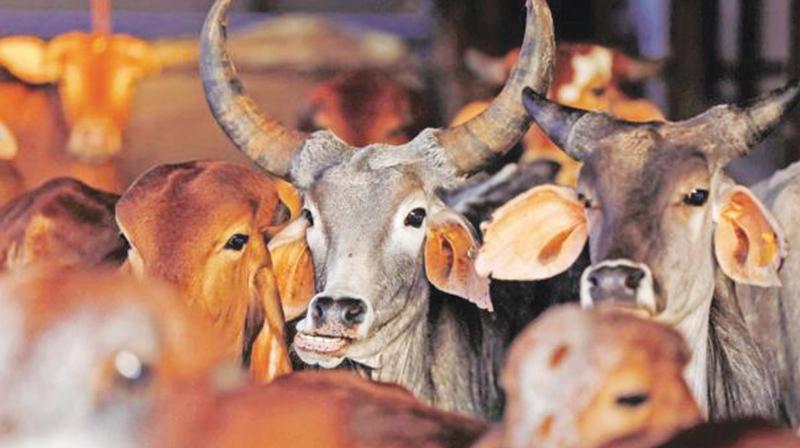Milking beef issue could tear social fabric
It may be useful to record that as per 2012 data. India ranked 5th in world beef production and 1st in beef export.

Three years of the Modi government has been the focus of attention through this week on television talk shows and newspaper opinion pieces. While the government and its leadership has been hailed for its visible, efficient and effective communication strategies its low key approach to the politics of inclusiveness has been projected as a severe limitation. As the media attention moves from three years completed to two years ahead a range of contentious issues await government attention. The debate on the ban of cow slaughter, will clearly gain centre stage in the coming months, especially in the run up to the state Assembly elections due in end 2017 and 2018 and the national elections of 2019. The debate has multiple contours. It has a constitutional/ legal angle. It also has a religious facet and above all it has the potential to be a potent electoral issue loaded with emotional overtones.
Ensuring clarity on a few issues would be place at the start of this discussion. On 26 May 2017, the Union Ministry of Environment issued a ban on the sale of cows and buffaloes for slaughter at animal markets across India. This was preceded by a lengthy and at times acrimonious debate on the issue of cow slaughter which often saw more ‘sound bytes’ rather than ‘sense bytes’. Reference is often made to Article 48 of the Indian Constitution, which is part of the Directive Principles of State Policy, which speak of prohibition of cow slaughter. It is important to record that in the last six decades, successive governments have demonstrated selective amnesia on the entire gamut of Directive Principles, often selectively identifying provisions among them for implementation. It must also be stressed that in 24 of the 29 states of India, there are legislations which provide for varying degrees of regulation on the slaughter or sale of cows. These legislations were upheld by the Supreme Court in a landmark judgment in 2005.
It would also be relevant to quote the entire provision of Article 48 of the Constitution: ‘The State shall endeavour to organize agriculture and animal husbandry on modern and scientific lines and shall, in particular, take step for preserving and improving the breeds, and prohibiting the slaughter of cows and calves and other milch and draught cattle (emphasis added). Some have argued that the above provision is limited to milk-yielding cattle. Yet it must be stressed that the Supreme Court judgment of 2005 states that if cattle seize to be milch or draught, they cannot be taken out of the category of ‘other milch and draught cattle’. Thus unless other reviewed by the Supreme Court, this position represents the ‘accepted legal position’ as of today. The decision of the Union Ministry of Environment, thus is in consonance with this judgment of the Supreme Court.
Yet, the debate has much wider ramifications and it is important to stress two other dimensions. Firstly, what is sold as ‘beef’ in India, is more often than not, buffalo meat and not the meat of cows. As mentioned earlier, restriction on slaughter and sale of cows is restricted by legislation in all but five states of India. It may be useful to record that as per 2012 data. India ranked 5th in world beef production (Beef in Indian context as defined above) and 1st in beef export. Thus, the perception that ‘beef’ refers to the cow is misplaced and only refers to buffalo meat, on which there is no constitutional/legal restriction. It is also argued by many that what is sold as beef in many parts of the country, is in reality buffalo meat.
The second and more contentious point relates, to the emotional frenzy and communal polarization that has been whipped up by segments in society who wish to gain political/ electoral support through this politics of divisiveness. Vigilante groups across the country have taken the law into their own hands and have targeted and attacked certain sections of society for either transporting cattle for slaughter or possessing/ consuming beef. The assumption of such ‘self-styled’ law enforcers is that the ‘beef’ in question is the cow and prefer not to make the distinction between buffalo meat and the cow. Emotions are then whipped up stating that the cow which is sacred for the Hindu community is being slaughtered/ stored/ consumed by people in the country and therefore need to be publically lynched without clarifying as to whether the meat in question called beef is buffalo meat or the cow. It becomes convenient not to make the distinction, as selective facts help in achieving the emotional polarization and targeting that these groups hope to achieve.
While one could welcome legislation that seeks to ban cow slaughter, one also needs to stress the fact that this ban is already in place and only needs to be strictly implemented and not selectively targeted. Further, the important distinction in India on what constitutes ‘beef’ needs to be underscored and made part of the public discussion so that this popular perception that ‘beef’ automatically refers to the cow is negated.
Yet in the game of social polarization for electoral gains it is often more convenient and comfortable to allow misperceptions to continue and not make the required distinctions as it serves one purpose eminently. One needs to bring an element of sanity, rationality and factual accuracy in this debate on the ban on cow slaughter so as to ensure that vested interests do not conveniently push the debate in the direction of social polarization to serve partisan political/electoral interests.
The writer is Pro-Vice Chancellor, Jain University

